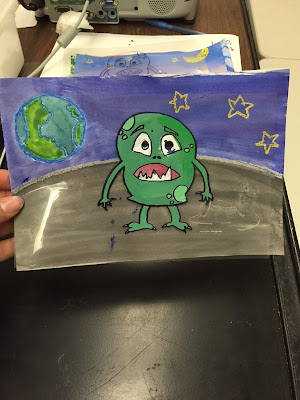Animation cels are named as such because the characters are designed and hand-drawn onto clear celluloid sheets. The characters can then be painted and placed in front of painted backgrounds. In animation, thousands of these cels would be taped with a camera and could create the illusion of depth of a character in front of a background.

Although we won't be creating thousands of cels for animated shorts, we are creating single cels by hand and, later in the year, we will create multi-layer images digitally. I think the students will see quite a difference!!
I showed them an example of how the layers work together to make one cohesive image:
(excuse the chipping paint... this guy has been through a LOT the past two weeks!)
To begin, the students were tasked with creating their own character. I gave them some drawing sheets and we looked at books for inspiration, but ultimately the characters were unique and the only rule was that the students had to love them. We have humans, animals, monsters, and even machines! The wide variety is making these classes really fun!
Many students sketched out several ideas during our drawing brainstorm class before ultimately settling on "their" character. Once they had settled on a design they were able to trace it onto the cel sheets (a great use for leftover overhead transparency!).
Many students this week are ready to start working on painting their backgrounds. We are using a method of sketching out our ideas very lightly with pencil, then tracing the lines with crayons and using the wax of the crayons to add texture before painting with the watercolors. The students have liked the way that the crayon adds interest while helping them to control the watercolor (the wax acts as a bit of a barrier between sections. Although unfinished, they are coming out great so far!
I can't wait to see these characters come to life when the students paint them in!





























